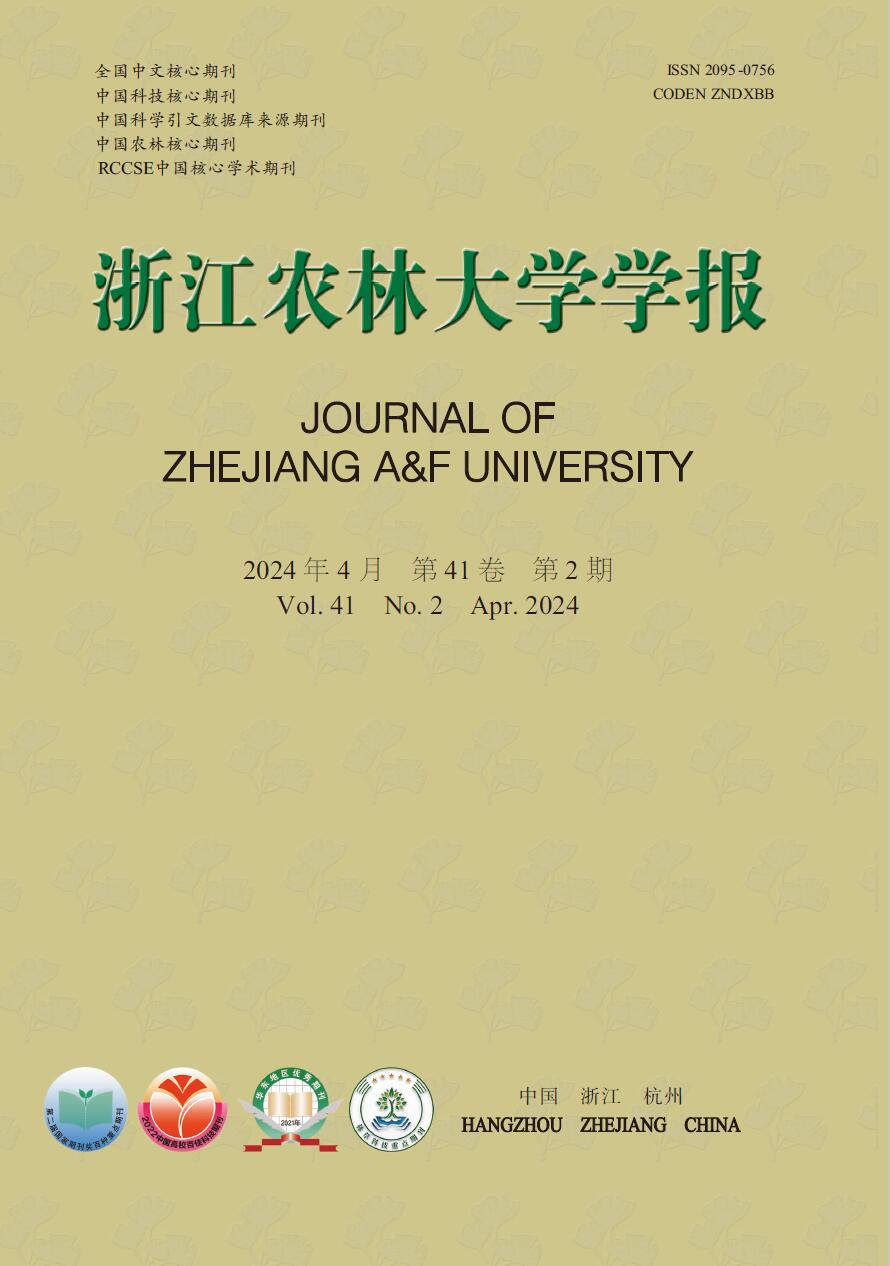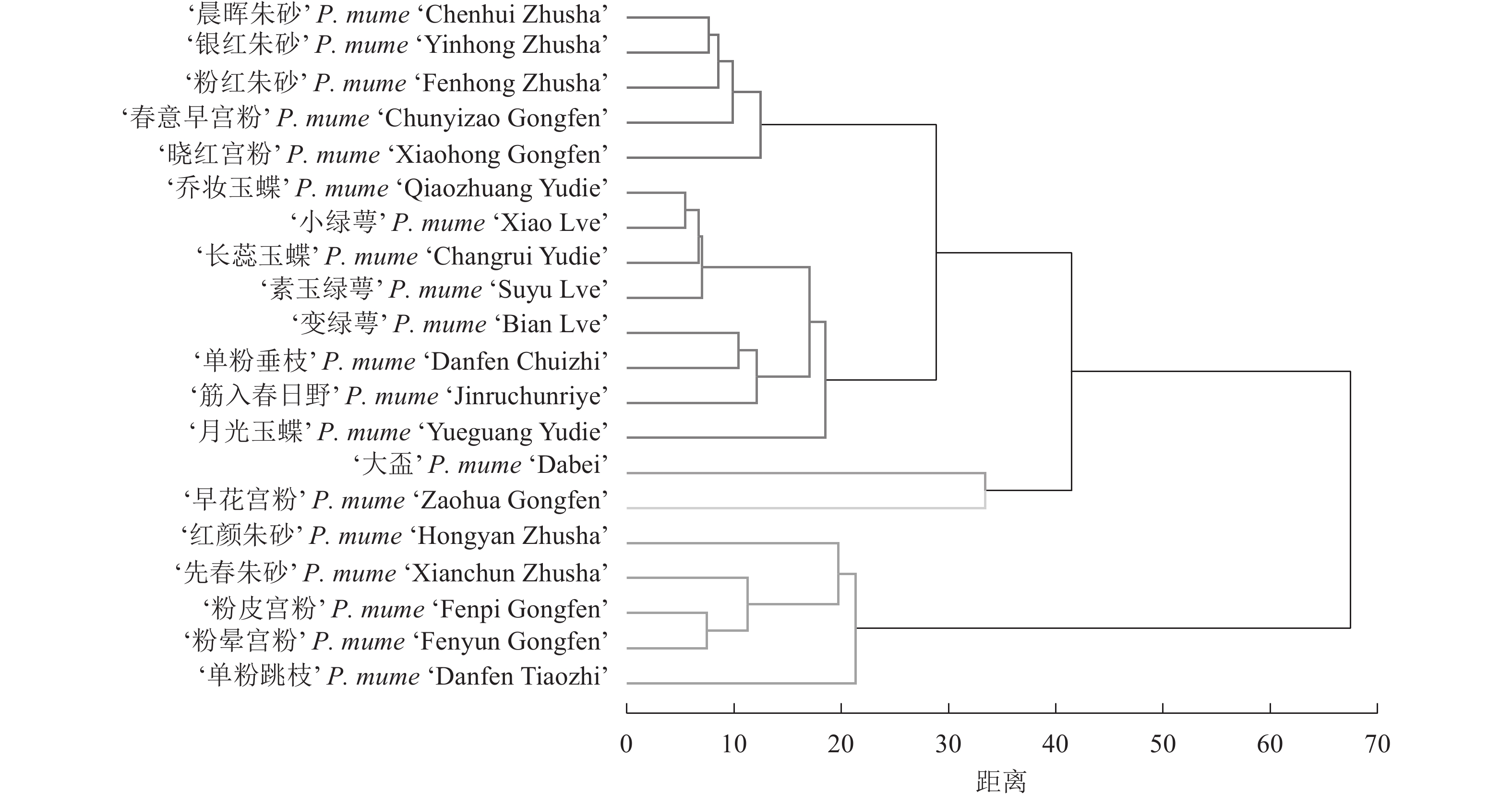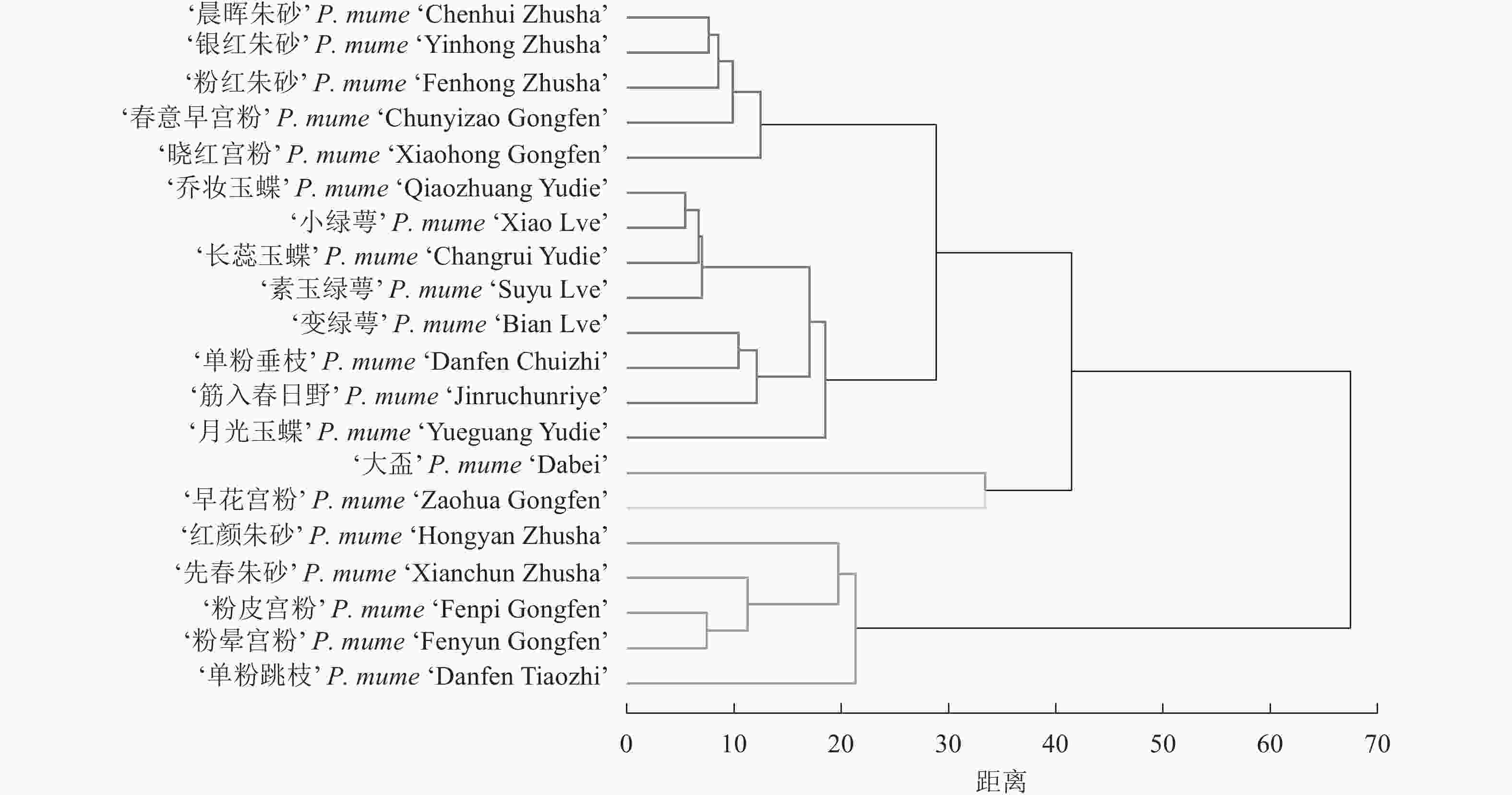-
梅花Prunus mume为蔷薇科Rosaceae李属Prunus植物,是中国十大传统名花之一,具有悠久的栽培和应用历史[1]。与李属其他植物相比,梅花具有独特的香气[2]。梅花品种繁多,目前在全世界范围内已登录486个梅花品种[3]。陈俊愉等[4]提出了梅花分类的新方案,将梅花分为11个品种群,其中有9个品种群来源于原真梅系,其余2个品种群来源于梅的种间杂交。梅花不同品种具有不同的香气,这些香气成分对香精、香料工业具有潜在的应用价值[5−6]。
植物花香是花朵散发出的挥发性低分子量化合物,这些物质不仅能参与植物体内的次生代谢,还能在植物抵御外来侵略方面起到作用[7]。迄今为止,已鉴定了超过2 100种天然花香物质[8−9]。按照花香物质的代谢途径,可将其分为萜烯类化合物、苯丙烷类/苯环型化合物和脂肪族化合物三大类[10]。蔷薇科植物主要释放苯环及苯丙烷类化合物,如苯甲醛、苯甲醇、乙酸苯甲酯、苯甲酸苯甲酯、丁子香酚、异丁子香酚等[11]。植物种类不同,其花朵释放的挥发物种类与含量也不同,产生的香气也具有植物个体特异性[12]。梅花香气物质在不同品种间具有一定的差异,在梅花中共鉴定出几十种化合物,最主要的香气物质包括乙酸苯甲酯、丁子香酚、苯甲醛、苯甲醇、乙酸肉桂酯等[13−17]。然而,不同梅花品种的花香多样性尚未被确定。鉴于此,本研究采用顶空固相微萃取法(HS-SPME)结合气相色谱-质谱(GC-MS)对6个品种群20个梅花品种的花香成分差异进行研究,筛选对梅花花香有较大贡献特征的香气物质,以期为梅花花香的代谢释放机制研究和深度经济价值(如精油、梅花茶等)开发提供参考。
-
所有梅花品种保存于浙江农林大学梅花种质资源圃。选取株龄相同、长势一致的梅花品种,共20个品种,6个品种群。其中:朱砂品种群有6个品种,分别为‘晨晖朱砂’‘Chenhui Zhusha’‘粉红朱砂’‘Fenhong Zhusha’‘红颜朱砂’‘Hongyan Zhusha’‘先春朱砂’‘Xianchun Zhusha’‘银红朱砂’‘Yinhong Zhusha’‘大盃’‘DaBei’;宫粉品种群有5个品种,分别为‘粉皮宫粉’‘Fenpi Gongfen’‘粉晕宫粉’‘Fenyun Gongfen’‘晓红宫粉’‘Xiaohong Gongfen’‘早花宫粉’‘Zaohua Gongfen’‘春意早宫粉’‘Chunyizao Gongfen’;绿萼品种群有3个品种,分别为‘变绿萼’‘Bian Lve’‘小绿萼’‘Xiao Lve’‘素玉绿萼’‘Suyu Lve’;玉蝶品种群有3个品种,分别为‘乔妆玉蝶’‘Qiaozhuang Yudie’‘月光玉蝶’‘Yueguang Yudie’‘长蕊玉蝶’‘Changrui Yudie’;垂枝品种群有1个品种,为‘单粉垂枝’‘Danfen Chuizhi’;跳枝品种群有2个品种,分别为‘单粉跳枝’‘Danfen Tiaozhi’和‘筋入春日野’‘Jinruchunriye’。所用试剂为C7~C30正构烷烃混合标准品(Sigma公司,德国)。
-
用镊子取下3朵盛开期的梅花,将其快速转移至22 mL的采样瓶,封口膜密封瓶盖,平衡10 min,将固相微萃取SPME纤维头(Supelco公司,美国)插入花朵上方2 cm处的采样瓶中吸附30 min。将吸附完花香的萃取头插入GC-MS联用仪的进样口进行分析,3次平行重复实验。GC-MS分析条件:色谱柱HP-5MS (30.00 m×250.00 μm×0.25 μm),载入氦气,流速1.2 mL·min−1;起始柱温为45 ℃,保持3 min,以5 ℃·min−1升至120 ℃,然后以6 ℃·min−1升温至260 ℃,保持3 min,离子电离能量70 eV,离子阱温度为230 ℃。每个品种3次生物学重复。
-
在相同分析条件下,测定C7~C30正构烷烃混合标准品,计算待鉴定化合物的保留指数,并结合GC-MS联用仪计算机的NIST05a.L/NIST11.L标准谱库自动检索分析各组分。保留指数计算公式[18]为IR=100n+100(t−tn)/(tn+1−tn)。其中:IR为保留指数,n和n+1分别为目标化合物出峰前后正构烷烃的碳原子数,tn和tn+1分别为相应正构烷烃的保留时间,t为待鉴定化合物在谱图中的保留时间(tn<t<tn+1)。依据总离子流各色谱峰平均峰面积,并通过面积归一化方法计算各香气成分的相对含量。
通过文献查找主要花香化合物的香气阈值,结合花香化合物的相对含量计算其香气贡献值,相对含量与香气阈值的比值即为香气贡献值。使用Origin 2021绘制花香成分的聚类分析图。
-
在20个梅花品种中共鉴定出43种挥发性成分,包括苯环/苯丙烷类化合物23种,萜烯类化合物7种,脂肪酸衍生物9种,烷烃类4种(表1)。朱砂品种群检测到的成分最多,有35种,包括苯环/苯丙烷类16种,萜烯类7种,脂肪酸衍生物9种,烷烃类3种;宫粉品种群共检测到30种成分,包括苯环/苯丙烷类20种,萜烯类4种,脂肪酸衍生物3种,烷烃类3种;玉蝶品种群共检测到20种成分,包括苯环/苯丙烷类13种,萜烯类3种,脂肪酸衍生物4种;绿萼品种群共检测到23种成分,包括苯环/苯丙烷类15种,萜烯类3种,脂肪酸衍生物5种;跳枝品种群共检测到28种成分,包括苯环/苯丙烷类15种,萜烯类6种,脂肪酸衍生物7种;垂枝品种群共检测到17种成分,包括苯环/苯丙烷类9种,萜烯类4种,脂肪酸衍生物4种。不同类型化合物的相对含量也存在较大差异,苯环/苯丙烷类的相对含量最高,为87.01%~99.87%,脂肪酸衍生物的相对含量为0~6.95%,萜烯类物质的相对含量为0~6.15%。
品种群 苯环/苯丙
烷类/种萜烯类/
种脂肪酸衍
生物/种烷烃/
种总数/
种朱砂 16 7 9 3 35 宫粉 20 4 3 3 30 玉蝶 13 3 4 − 20 绿萼 15 3 5 − 23 跳枝 15 6 7 − 28 垂枝 9 4 4 − 17 总数/种 23 7 9 4 43 总相对含量/% 87.01~99.87 0~6.15 0~6.95 0~0.18 说明:−表示未检测到。 Table 1. Category and relative content of volatile components in six cultivar groups of P. mume
-
如表2所示:‘晨晖朱砂’中乙酸苯甲酯(44.97%)、苯甲醇(41.83%)、丁子香酚(5.98%)和苯甲醛(2.84%)等相对含量较高。‘粉红朱砂’与‘晨晖朱砂’相似,其最主要的花香成分为乙酸苯甲酯(48.25%)、苯甲醇(34.21%)、丁子香酚(5.25%)和苯甲醛(5.24%)等。‘红颜朱砂’中苯甲醇(72.86%)、丁子香酚(7.37%)、肉桂醇(5.97%)和苯甲醛(5.61%)等相对含量较高。‘先春朱砂’中苯甲醇(63.15%)、肉桂醇(13.67%)、苯甲醛(8.72%)和丁子香酚(7.59%)等相对含量较高。‘银红朱砂’的挥发性成分为乙酸苯甲酯(50.48%)、苯甲醇(39.96%)和丁子香酚(3.93%)等相对含量较高。‘大盃’中乙酸苯甲酯(25.56%)、苯甲醛(17.53%)、草蒿脑(12.44%)、丁子香酚(10.50%)、4-(2-丙烯基)苯酚(9.66%)和乙酸-2-己烯酯(4.63%)等相对含量较高。
化合物 保留指数 相对含量/% ‘晨晖朱砂’ ‘粉红朱砂’ ‘红颜朱砂’ ‘先春朱砂’ ‘银红朱砂’ ‘大盃’ 对二甲苯 p-xylene 896 2.75±0.57 3.08±0.37 2.08±0.78 3.24±0.88 1.64±0.45 5.20±1.61 苯甲醛 benzaldehyde 973 2.84±1.24 5.24±4.44 5.61±3.08 8.72±5.64 1.18±0.25 17.53±1.20 苯甲醇 benzyl alcohol 1 041 41.83±1.67 34.21±1.57 72.86±5.64 63.15±8.15 39.96±2.62 5.78±1.69 乙酸苯甲酯 benzyl acetate 1 171 44.97±4.91 48.25±3.64 1.16±0.12 1.47±0.16 50.48±3.16 25.56±8.21 水杨酸甲酯 methyl salicylate 1 197 − − − − − 0.08±0.07 草蒿脑 estragole 1 201 0.08±0.04 − 0.26±0.10 − − 12.44±3.57 3,4-二甲氧基甲苯 3,4-dimethoxytoluene 1 242 − − − − − 0.07±0.05 3-苯丙醇 3-phenylpropanol 1 233 − − 0.37±0.18 0.40±0.13 − − 4-(2-丙烯基)苯酚 phenol-4-(2-propenyl)- 1 255 − 0.16±0.09 0.22±0.07 0.21±0.08 − 9.66±3.34 反式肉桂醛 cinnamaldehyde, (E)- 1 272 − − 0.35±0.11 0.75±0.29 0.07±0.06 − 肉桂醇 cinnamyl alcohol 1 307 − 1.36±0.58 5.97±1.67 13.67±4.18 1.04±0.48 − 丁子香酚 eugenol 1 360 5.98±2.00 5.25±1.61 7.37±1.95 7.59±1.37 3.93±0.71 10.50±1.68 丁酸-3-苯丙酯 3-phenylpropyl butyrate 1 373 − 0.07±0.01 − − 0.08±0.01 − 甲基丁香酚 methyleugenol 1 406 0.15±0.05 − 0.30±0.11 0.07±0.05 − 0.46±0.09 乙酸肉桂酯 cinnamyl acetate 1 447 − 1.33±0.34 0.20±0.05 0.59±0.13 0.77±0.21 − 邻苯二甲酸二甲酯 dimethyl phthalate 1 458 0.19±0.08 − 0.79±0.53 − − − 苯基/苯丙烷类合计
total phenylpropanoids/ benzenoids98.79 98.95 97.55 99.87 99.15 87.01 莰烯 camphene 963 0.15±0.12 − 1.32±0.18 − − 1.52±0.54 6-甲基-5-庚烯-2-酮 sulcatone 1 003 − − − − − 0.07±0.05 柠檬烯 limonene 1 038 − − − − − 0.17±0.04 3-蒈烯 3-carene 1 056 − − − − − 3.82±2.51 γ-松油烯 γ-terpinene 1 066 − − − − − 0.03±0.02 莰酮 camphor 1 149 − − 0.36±0.05 − − 0.22±0.03 β-紫罗兰酮 β-ionone 1 490 0.11±0.09 − 0.13±0.03 − 0.05±0.03 0.32±0.08 萜烯类合计 total terpenoids 0.26 0.00 1.82 0.00 0.05 6.15 异戊醇 isoamyl alcohol 801 − − − − − 0.16±0.12 己醛 hexanal 845 0.10±0.05 − − − − − 乙酸戊酯 n-amylacetate 935 − − − − − 0.17±0.15 乙酸叶醇酯 cis-3-hexe-nylacetate 1 018 0.17±0.04 0.30±0.05 − − 0.39±0.11 1.37±0.18 乙酸-2-己烯酯 2-hexen-1-ol acetate 1 027 0.46±0.14 0.75±0.16 − − 0.42±0.30 4.63±0.76 壬醛 nonanal 1 109 − − − − − 0.05±0.04 癸醛 decanal 1 208 − − − − − 0.07±0.05 二乙二醇丁醚醋酸酯
2-(2-butoxyethoxy)-ethanol acetate1 369 0.21±0.13 − 0.65±0.11 − − − 月桂酸甲酯 methyl laurate 1 525 − − − − − 0.04±0.03 脂肪酸衍生物合计 total fatty acid derivatives 0.95 1.05 0.65 0.00 0.81 6.49 十三烷 tridecane 1 300 − − − − − 0.08±0.05 十九烷 nonadecane 1 900 − − − 0.08±0.01 − − 二十一烷 heneicosane 2 100 − − − 0.05±0.03 − − 烷烃类合计 total alkanes 0.00 0.00 0.00 0.13 0.00 0.08 说明:−表示未检测到。 Table 2. Aromatic compounds and the relative content of Cinnabar Purple group of P. mume
对梅花香气贡献率(表3)的计算发现:β-紫罗兰酮、肉桂醇、丁子香酚和甲基丁香酚对朱砂品种群梅花的香气的贡献率较高。由于β-紫罗兰酮的香气阈值很低,所以其在梅花花朵香气中的贡献率最高。
化合物 香气阈值 香气贡献值/% ‘晨晖朱砂’ ‘粉红朱砂’ ‘红颜朱砂’ ‘先春朱砂’ ‘银红朱砂’ ‘大盃’ 苯甲醛
benzaldehyde0.350~3.500 0.810~8.110 1.640~16.380 1.600~16.030 2.490~24.910 0.340~3.370 5.010~50.090 苯甲醇
benzyl alcohol80.000 0.523 0.428 0.911 0.789 0.500 0.072 乙酸苯甲酯
benzyl acetate2.600 17.297 18.558 0.445 0.567 19.415 9.831 草蒿脑
estragole0.016 5.000 − 16.250 − − 777.500 丁子香酚
eugenol0.006~0.030 199.330~996.670 175.000~875.000 245.670~1 228.330 253.000~1 265.000 131.000~655.000 350.000~1 750.000 甲基丁香酚
methyleugenol0.001 146.667 − 296.667 66.667 − 180.000 β-紫罗兰酮
β-ionone0.000 15 238.095 − 19 047.619 − 6 666.667 46 190.476 壬醛
nonanal0.001 − − − − − 53.333 癸醛
decanal0.001~0.002 − − − − − 35.000~70.000 肉桂醇
cinnamyl alcohol0.001 − 1 700.000 7 466.667 17 087.500 1 295.833 − 异戊醇
isoamyl alcohol0.006 − − − − − 25.683 乙酸叶醇酯
cis-3-hexe-nylacetate0.009 19.259 33.704 − − 43.333 151.852 说明:−表示未检测到。 Table 3. Aroma contribution value of floral scent compounds from Cinnabar Purple group of P. mume
-
如表4所示:‘粉皮宫粉’中苯甲醇(53.90%)、肉桂醇(16.19%)、苯甲醛(11.44%)和丁子香酚(9.35%)等相对含量较高。‘粉晕宫粉’与‘粉皮宫粉’相似,其中苯甲醇(54.94%)、肉桂醇(19.83%)、丁子香酚(9.57%)和苯甲醛(5.10%)等是其主要的花香成分。‘晓红宫粉’中乙酸苯甲酯(53.19%)、苯甲醇(30.57%)和丁子香酚(7.13%)等相对含量较高。‘早花宫粉’中苯甲醇(30.31%)、乙酸苯甲酯(25.32%)、乙酸肉桂酯(9.94%)、丁子香酚(9.15%)、苯甲醛(8.74%)和肉桂醇(7.42%)等为主要的香气成分。‘春意早宫粉’中乙酸苯甲酯(46.72%)、苯甲醇(40.05%)、丁子香酚(7.13%)和苯甲醛(4.06%)等为主要的香气物质。
化合物 保留指数 相对含量/% ‘粉皮宫粉’ ‘粉晕宫粉’ ‘晓红宫粉’ ‘早花宫粉’ ‘春意早宫粉’ 对二甲苯 p-xylene 896 2.00±0.08 2.89±0.61 5.38±3.15 4.17±1.33 1.80±0.24 苯甲醛 benzaldehyde 973 11.44±1.89 5.10±3.94 2.45±1.37 8.74±1.64 4.06±1.31 苄甲醚 benzyl methyl ether 999 − − − − 0.04±0.03 对甲苯甲醚 p-methylanisole 1 029 0.56±0.12 0.51±0.15 − − − 苯甲醇 benzyl alcohol 1 041 53.90±3.71 54.94±9.98 30.57±6.39 30.31±4.00 40.05±1.42 对甲酚 p-cresol 1 080 0.06±0.05 0.07±0.05 − − − 苯甲酸甲酯 methyl benzoate 1 099 − − − 0.57±0.35 − 乙酸苯甲酯 benzyl acetate 1 171 1.54±0.11 1.20±0.13 53.19±8.71 25.32±4.67 46.72±1.19 2-甲氧基-4-甲基苯酚 creosol 1 195 0.07±0.01 − − 0.05±0.04 − 草蒿脑 estragole 1 201 0.17±0.05 0.15±0.04 − 0.12±0.02 0.05±0.00 3-苯丙醇 3-phenylpropanol 1 233 0.38±0.08 0.65±0.24 − 0.12±0.05 0.07±0.00 4-(2-丙烯基)苯酚 phenol-4-(2-propenyl)- 1 255 0.23±0.03 0.32±0.16 0.09±0.04 0.63±0.22 − 反式肉桂醛 cinnamaldehyde, (E)- 1 272 0.89±0.28 1.07±0.50 − 1.22±0.36 0.09±0.02 肉桂醇 cinnamyl alcohol 1 307 16.19±5.50 19.83±9.73 − 7.42±1.96 1.46±0.17 丁子香酚 eugenol 1 360 9.35±0.92 9.57±1.02 7.13±0.90 9.15±1.09 3.33±0.30 丁酸-3-苯丙酯 3-phenylpropyl butyrate 1 373 − − − − 0.17±0.02 甲基丁香酚 methyleugenol 1 406 0.17±0.02 0.17±0.02 0.05±0.03 0.09±0.02 0.11±0.03 乙酸肉桂酯 cinnamyl acetate 1 447 0.81±0.08 0.77±0.10 − 9.94±1.43 1.13±0.11 邻苯二甲酸二甲酯 dimethyl phthalate 1 458 − 0.19±0.06 − 0.03±0.02 − 苯甲酸苯甲酯 benzyl benzoate 1 771 0.40±0.04 0.31±0.09 − 0.35±0.02 − 苯基/苯丙烷类合计 total phenylpropanoids/ benzenoids 98.15 97.75 98.86 98.21 99.07 莰烯 camphene 963 0.61±0.49 0.67±0.56 0.23±0.18 0.23±0.13 0.24±0.06 3-蒈烯 3-carene 1 056 0.86±0.58 1.03±0.87 − − − 莰酮 camphor 1 149 0.13±0.07 0.16±0.08 0.16±0.07 0.17±0.14 0.07±0.03 β-紫罗兰酮 β-ionone 1 490 0.25±0.12 0.19±0.12 − − 0.08±0.01 萜烯类合计 total terpenoids 1.85 2.04 0.39 0.40 0.39 乙酸叶醇酯 cis-3-hexe-nylacetate 1 018 − − 0.26±0.13 0.18±0.02 0.26±0.02 乙酸-2-己烯酯 2-hexen-1-ol acetate 1 027 − − 0.49±0.07 1.01±0.33 0.28±0.03 二乙二醇丁醚醋酸酯 2-(2-butoxyethoxy)-ethanol acetate 1 369 − 0.20±0.04 − − − 脂肪酸衍生物合计 total fatty acid derivatives 0.00 0.20 0.75 1.19 0.54 十五烷 pentadecane 1 500 − − − 0.11±0.03 − 十九烷 nonadecane 1 900 − − − 0.02±0.02 − 二十一烷 heneicosane 2 100 − − − 0.05±0.04 − 烷烃类合计 total alkanes 0.00 0.00 0.00 0.18 0.00 说明:−表示未检测到。 Table 4. Aromatic compounds and the relative content of Pink Double group of P. mume
如表5所示:在‘粉晕宫粉’和‘粉皮宫粉’中,香气贡献值从高到低依次是β-紫罗兰酮、肉桂醇、对甲苯甲醚、丁子香酚和甲基丁香酚,未检测到乙酸叶醇酯。‘晓红宫粉’香气贡献值从高到低依次是丁子香酚、甲基丁香酚、乙酸叶醇酯和乙酸苯甲酯。‘早花宫粉’香气贡献值从高到低依次是肉桂醇、丁子香酚和甲基丁香酚。在‘春意早宫粉’中,香气贡献值从高到低依次是β-紫罗兰酮、肉桂醇、丁子香酚和甲基丁香酚。
化合物 香气阈值 香气贡献值/% ‘粉皮宫粉’ ‘粉晕宫粉’ ‘晓红宫粉’ ‘早花宫粉’ ‘春意早宫粉’ 苯甲醛 benzaldehyde 0.350~3.500 3.270~32.690 1.460~14.570 0.700~7.000 2.500~24.970 1.160~11.600 苯甲醇 benzyl alcohol 80.000 0.674 0.687 0.382 0.379 0.501 乙酸苯甲酯 benzyl acetate 2.600 0.594 0.462 20.458 9.737 17.969 草蒿脑 estragole 0.016 10.417 9.375 − 7.708 3.333 丁子香酚 eugenol 0.006~0.030 311.670~1558.330 319.000~1595.000 237.670~1 188.330 305.000~1525.000 111.000~555.000 甲基丁香酚 methyleugenol 0.001 166.667 173.333 46.667 90.000 110.000 β-紫罗兰酮 β-ionone 0.000 35 714.286 27 142.857 − − 10 952.381 对甲苯甲醚 p-methylanisole 0.000 2 800.000 2 566.667 − − − 肉桂醇 cinnamyl alcohol 0.001 20 241.667 24 787.500 − 9 270.833 1 825.000 乙酸叶醇酯 cis-3-hexe-nylacetate 0.009 − − 29.259 20.370 28.889 说明:−表示未检测到。 Table 5. Aroma contribution value of floral scent compounds from Pink Double group of P. mume
-
如表6所示:‘乔妆玉蝶’中乙酸苯甲酯(62.67%)、苯甲醇(24.35%)、丁子香酚(5.36%)和苯甲醛(4.42%)等相对含量较高。‘月光玉蝶’中乙酸苯甲酯(72.90%)、苯甲醛(7.83%)、苯甲醇(7.73%)和丁子香酚(3.06%)等相对含量较高。‘长蕊玉蝶’中乙酸苯甲酯(62.63%)、苯甲醇(18.80%)、丁子香酚(6.17%)和苯甲醛(5.94%)等相对含量较高。
化合物 保留指数 相对含量/% ‘乔妆玉蝶’ ‘月光玉蝶’ ‘长蕊玉蝶’ 乙基苯 ethylbenzene 889 − 0.10±0.08 − 对二甲苯 p-xylene 896 2.10±0.19 2.66±0.82 1.71±0.96 苯甲醛 benzaldehyde 973 4.42±0.44 7.83±2.17 5.94±4.00 苯甲醇 benzyl alcohol 1 041 24.35±6.23 7.73±2.29 18.80±5.01 苯甲酸甲酯 methyl benzoate 1 099 0.14±0.05 − − 乙酸苯甲酯 benzyl acetate 1 171 62.67±4.41 72.90±6.01 62.63±5.69 水杨酸甲酯 methyl salicylate 1 197 − − 0.06±0.05 草蒿脑 estragole 1 201 − 0.13±0.05 1.09±1.22 4-(2-丙烯基)苯酚 phenol-4-(2-propenyl)- 1 255 0.13±0.11 − 1.01±1.21 丁子香酚 eugenol 1 360 5.36±0.93 3.06±0.50 6.17±1.95 甲基丁香酚 methyleugenol 1 406 − 0.38±0.02 0.28±0.10 邻苯二甲酸二甲酯 dimethyl phthalate 1 458 − 0.11±0.10 0.22±0.18 苯甲酸苯甲酯 benzyl benzoate 1 771 − 0.13±0.12 − 苯基/苯丙烷类合计 total phenylpropanoids/ benzenoids 99.17 95.02 97.92 莰烯 camphene 963 0.24±0.08 0.07±0.06 0.38±0.25 莰酮 camphor 1 149 0.13±0.04 − 0.05±0.04 β-紫罗兰酮 β-ionone 1 490 − − 0.05±0.04 萜烯类合计 total terpenoids 0.38 0.07 0.49 乙酸戊酯 n-amylacetate 935 − 0.15±0.04 − 乙酸叶醇酯 cis-3-hexe-nylacetate 1 018 0.07±0.06 1.69±0.66 0.64±0.39 乙酸-2-己烯酯 2-hexen-1-ol acetate 1 027 0.38±0.19 2.95±1.10 0.66±0.49 二乙二醇丁醚醋酸酯 2-(2-butoxyethoxy)-ethanol acetate 1 369 − 0.12±0.11 0.29±0.24 脂肪酸衍生物合计 total fatty acid derivatives 0.45 4.91 1.59 说明:−表示未检测到。 Table 6. Aromatic compounds and the relative content of Alboplena group of P. mume
如表7所示:在‘长蕊玉蝶’中,香气贡献值从高到低依次是β-紫罗兰酮、丁子香酚、甲基丁香酚、乙酸叶醇酯、乙酸苯甲酯和草蒿脑。在‘月光玉蝶’中,香气贡献值从高到低依次是丁子香酚、甲基丁香酚、乙酸叶醇酯和乙酸苯甲酯,未检测到β-紫罗兰酮。‘乔妆玉蝶’中香气贡献值从高到低是丁子香酚和乙酸苯甲酯。
化合物 香气阈值 香气贡献值/% ‘乔妆玉蝶’ ‘月光玉蝶’ ‘长蕊玉蝶’ 苯甲醛 benzaldehyde 0.350~3.500 1.260~12.630 2.240~22.370 1.700~16.970 苯甲醇 benzyl alcohol 80.000 0.304 0.097 0.235 乙酸苯甲酯 benzyl acetate 2.600 24.103 28.037 24.090 草蒿脑 estragole 0.016 − 8.125 68.333 丁子香酚 eugenol 0.006~0.030 178.670~893.330 102.000~510.000 205.670~1 028.330 甲基丁香酚 methyleugenol 0.001 − 376.667 276.667 β-紫罗兰酮 β-ionone 0.000 − − 7 619.048 乙酸叶醇酯 cis-3-hexe-nylacetate 0.009 7.778 187.778 71.481 说明:−表示未检测到。 Table 7. Aroma contribution value of floral scent compounds from Alboplena group of P. mume
-
如表8所示:‘变绿萼’中乙酸苯甲酯(57.43%)、苯甲醛(14.67%)、苯甲醇(8.26%)、对甲苯甲醚(5.41%)和丁子香酚(5.34%)等相对含量较高。‘小绿萼’中乙酸苯甲酯(65.13%)、苯甲醇(23.37%)和丁子香酚(3.74%)等相对含量较高。‘素玉绿萼’中乙酸苯甲酯(59.20%)、苯甲醇(24.56%)、丁子香酚(5.81%)和苯甲醛(5.45%)等相对含量较高。
化合物 保留指数 相对含量/% ‘变绿萼’ ‘小绿萼’ ‘素玉绿萼’ 对二甲苯 p-xylene 896 2.49±1.74 1.57±0.59 0.73±0.22 苯甲醛 benzaldehyde 973 14.67±3.77 2.73±0.41 5.45±1.16 对甲苯甲醚 p-methylanisole 1 029 5.41±1.57 − − 苯甲醇 benzyl alcohol 1 041 8.26±1.41 23.37±5.36 24.56±0.85 对甲酚 p-cresol 1 080 0.05±0.04 − − 苯甲酸甲酯 methyl benzoate 1 099 0.33±0.10 − − 乙酸苯甲酯 benzyl acetate 1 171 57.43±4.67 65.13±4.33 59.20±1.79 水杨酸甲酯 methyl salicylate 1 197 0.25±0.08 − − 草蒿脑 estragole 1 201 0.81±0.18 0.09±0.07 1.26±0.30 3,4-二甲氧基甲苯 3,4-dimethoxytoluene 1 242 0.09±0.07 − − 4-(2-丙烯基)苯酚 phenol-4-(2-propenyl)- 1 255 0.27±0.18 − 0.89±0.33 丁子香酚 eugenol 1 360 5.34±0.44 3.74±1.54 5.81±0.61 甲基丁香酚 methyleugenol 1 406 0.46±0.21 0.28±0.17 0.31±0.03 邻苯二甲酸二甲酯 dimethyl phthalate 1 458 0.12±0.09 0.35±0.26 − 苯甲酸苯甲酯 benzyl benzoate 1 771 1.93±0.49 − − 苯基/苯丙烷类合计 total phenylpropanoids/ benzenoids 97.90 97.26 98.21 莰烯 camphene 963 − 0.40±0.20 0.16±0.05 莰酮 camphor 1 149 − 0.28±0.18 − β-紫罗兰酮 β-ionone 1 490 − 0.14±0.06 − 萜烯类合计 total terpenoids 0.00 0.82 0.16 异戊醇 isoamyl alcohol 801 0.31±0.27 − − 乙酸戊酯 n-amylacetate 935 0.17±0.06 − 0.07±0.01 乙酸叶醇酯 cis-3-hexe-nylacetate 1 018 1.41±0.77 0.70±0.25 0.41±0.14 乙酸-2-己烯酯 2-hexen-1-ol acetate 1 027 − 1.11±0.58 1.04±0.73 二乙二醇丁醚醋酸酯 2-(2-butoxyethoxy)-ethanol acetate 1 369 0.19±0.07 0.12±0.09 0.11±0.09 脂肪酸衍生物合计 total fatty acid derivatives 2.09 1.93 1.63 说明:−表示未检测到。 Table 8. Aromatic compounds and the relative content of Green Calyx group of P. mume
如表9所示:‘变绿萼’中香气贡献值从高到低依次是对甲苯甲醚、丁子香酚、甲基丁香酚、乙酸叶醇酯和异戊醇,未检测到β-紫罗兰酮。在‘小绿萼’中,香气贡献值从高到低依次是β-紫罗兰酮、丁子香酚、甲基丁香酚、乙酸叶醇酯和乙酸苯甲酯。在‘素玉绿萼’中,香气贡献值从高到低依次是丁子香酚、甲基丁香酚、乙酸叶醇酯和草蒿脑,未检测到β-紫罗兰酮。
化合物 香气阈值 香气贡献值/% ‘变绿萼’ ‘小绿萼’ ‘素玉绿萼’ 苯甲醛 benzaldehyde 0.350~3.500 4.190~41.910 0.780~7.800 1.560~15.570 苯甲醇 benzyl alcohol 80.000 0.103 0.292 0.307 乙酸苯甲酯 benzyl acetate 2.600 22.087 25.050 22.769 草蒿脑 estragole 0.016 50.833 5.833 78.750 丁子香酚 eugenol 0.006~0.030 178.000~890.000 124.670~623.330 193.670~968.330 甲基丁香酚 methyleugenol 0.001 460.000 280.000 310.000 β-紫罗兰酮 β-ionone 0.000 − 19523.810 − 对甲苯甲醚 p-methylanisole 0.000 27050.000 − − 异戊醇 isoamyl alcohol 0.006 51.366 − − 乙酸叶醇酯 cis-3-hexe-nylacetate 0.009 157.037 77.407 45.556 说明:−表示未检测到。 Table 9. Aroma contribution value of floral scent compounds from Green Calyx group of P. mume
-
如表10所示:‘单粉跳枝’中苯甲醇(59.78%)、苯甲醛(17.58%)、丁子香酚(5.50%)和肉桂醇(4.14%)等相对含量较高。‘筋入春日野’中乙酸苯甲酯(63.54%)、苯甲醇(12.20%)、苯甲醛(9.12%)和乙酸-2-己烯酯(4.31%)等相对含量较高。‘单粉垂枝’中乙酸苯甲酯(55.42%)、苯甲醛(16.53%)、苯甲醇(13.88%)、丁子香酚(4.88%)和乙酸-2-己烯酯(3.02%)等相对含量较高。
化合物 保留指数 相对含量/% ‘单粉跳枝’ ‘筋入春日野’ ‘单粉垂枝’ 对二甲苯 p-xylene 896 5.92±0.62 4.67±0.99 2.87±0.66 苯甲醛 benzaldehyde 973 17.58±0.46 9.12±2.60 16.53±3.54 苯甲醇 benzyl alcohol 1 041 59.78±1.26 12.20±5.77 13.88±4.66 乙酸苯甲酯 benzyl acetate 1 171 1.36±0.13 63.54±9.56 55.42±1.57 2-甲氧基-4-甲基苯酚 creosol 1 195 − 0.16±0.06 − 草蒿脑 estragole 1 201 0.40±0.05 0.16±0.04 0.25±0.08 3,4-二甲氧基甲苯 3,4-dimethoxytoluene 1 242 − 0.11±0.02 − 3-苯丙醇 3-phenylpropanol 1 233 0.24±0.06 − − 4-(2-丙烯基)苯酚 phenol-4-(2-propenyl)- 1 255 0.19±0.01 − 0.22±0.04 反式肉桂醛 cinnamaldehyde, (E)- 1 272 0.34±0.07 − − 肉桂醇 cinnamyl alcohol 1 307 4.14±1.34 − − 丁子香酚 eugenol 1 360 5.50±0.16 2.59±0.48 4.88±0.85 甲基丁香酚 methyleugenol 1 406 0.09±0.03 0.22±0.06 0.18±0.12 乙酸肉桂酯 cinnamyl acetate 1 447 0.14±0.10 − − 邻苯二甲酸二甲酯 dimethyl phthalate 1 458 0.57±0.36 0.13±0.11 0.36±0.16 苯基/苯丙烷类合计 total phenylpropanoids/ benzenoids 96.25 92.92 94.58 莰烯 camphene 963 1.99±0.59 − 1.02±0.08 6-甲基-5-庚烯-2-酮 sulcatone 1 003 − 0.08±0.06 − 柠檬烯 limonene 1 038 0.14±0.10 − 0.10±0.01 3-蒈烯 3-carene 1 056 − 0.06±0.04 − 莰酮 camphor 1 149 0.83±0.09 − 0.08±0.01 β-紫罗兰酮 β-ionone 1 490 0.14±0.07 − 0.08±0.07 萜烯类合计 total terpenoids 3.10 0.13 1.28 异戊醇 isoamyl alcohol 801 0.05±0.03 − − 己醛 hexanal 845 − 0.14±0.13 − 乙酸戊酯 n-amylacetate 935 − − 0.08±0.06 乙酸叶醇酯 cis-3-hexe-nylacetate 1 018 − 2.36±1.43 0.81±0.23 乙酸-2-己烯酯 2-hexen-1-ol acetate 1 027 − 4.31±2.65 3.02±0.77 壬醛 nonanal 1 109 0.11±0.03 − − 癸醛 decanal 1 208 0.12±0.02 − − 二乙二醇丁醚醋酸酯 2-(2-butoxyethoxy)-ethanol acetate 1 369 0.34±0.13 0.14±0.10 0.24±0.19 月桂酸甲酯 methyl laurate 1 525 − − − 脂肪酸衍生物合计 total fatty acid derivatives 0.61 6.95 4.15 说明:−表示未检测到。 Table 10. Aromatic compounds and the relative content of Versicolor group and Pendulous Mei group of P. mume
如表11所示:在‘单粉跳枝’中,香气贡献值从高到低依次是β-紫罗兰酮、肉桂醇、丁子香酚、甲基丁香酚、壬醛和癸醛。‘筋入春日野’中香气贡献值最高的依次是丁子香酚、乙酸叶醇酯和甲基丁香酚。‘单粉垂枝’香气贡献值最高的依次是β-紫罗兰酮、丁子香酚、甲基丁香酚和乙酸叶醇酯。
化合物 香气阈值 香气贡献值/% ‘单粉跳枝’ ‘筋入春日野’ ‘单粉垂枝’ 苯甲醛 benzaldehyde 0.350~3.500 5.020~50.230 2.610~26.060 4.720~47.230 苯甲醇 benzyl alcohol 80.000 0.747 0.153 0.174 乙酸苯甲酯 benzyl acetate 2.600 0.523 24.440 21.314 草蒿脑 estragole 0.016 24.792 9.729 15.833 丁子香酚 eugenol 0.006~0.030 183.330~916.670 86.330~431.670 162.670~813.340 甲基丁香酚 methyleugenol 0.001 93.333 223.667 176.667 β-紫罗兰酮 β-ionone 0.000 20 000.000 − 11 428.571 壬醛 nonanal 0.001 113.333 − − 癸醛 decanal 0.001~0.002 60.000~120.000 − − 肉桂醇 cinnamyl alcohol 0.001 5 175.000 − − 异戊醇 isoamyl alcohol 0.006 7.650 − − 乙酸叶醇酯 cis-3-hexe-nylacetate 0.009 − 262.296 90.000 说明:−表示未检测到。 Table 11. Aroma contribution value of floral scent compounds from Versicolor group and Pendulous Mei group of P. mume
-
如图1所示:20个梅花品种依据花香成分组成及相对含量,被分为5类。第1类为‘晨晖朱砂’‘银红朱砂’‘粉红朱砂’‘春意早宫粉’和‘晓红宫粉’,其花香成分特点是乙酸苯甲酯和苯甲醇相对含量较高,且相近。第2类为‘单粉垂枝’‘筋入春日野’、玉蝶品种群及绿萼品种群,其花香特点是乙酸苯甲酯相对含量最高,其次是苯甲醇,且苯甲醇相对含量远低于乙酸苯甲酯。第3类仅包括朱砂品种群的‘大盃’,其花香特点是乙酸苯甲酯、苯甲醛、草蒿脑相对含量均较高且相近,萜烯类物质相对含量也较高。第4类仅包括宫粉品种群的‘早花宫粉’,其花香特点是苯甲醇和乙酸苯甲酯相对含量最高,其次是乙酸肉桂酯、丁子香酚和苯甲醛。第5类包括‘红颜朱砂’‘先春朱砂’‘粉皮宫粉’‘粉晕宫粉’和‘单粉跳枝’,其花香成分组成特点是苯甲醇相对含量最高,均高于50%,其次是苯甲醛,而乙酸苯甲酯相对含量极低,均低于2%。
-
梅花是中国拥有第1个国际登录权的物种,目前已有超过400个梅花品种被登录[19]。郝瑞杰等[20]研究表明:决定梅花香气的主要成分是苯环/苯丙烷类化合物,其中以乙酸苯甲酯、苯甲醇、苯甲醛和丁子香酚等为主。本研究结果与郝瑞杰等[20]的研究结果一致,苯环/苯丙烷类化合物是梅花花香的主要成分,其中乙酸苯甲酯、苯甲醛、苯甲醇和丁子香酚占比最高,还含有少量萜烯类和脂肪酸类物质。ZHANG等[21]对8个不同花色梅花品种的花香成分进行了分析,表明苯基/苯丙烷类化合物占总排放量的95%以上。白花品种的花香挥发物以乙酸苯甲酯为主,品种间差异较小,粉花品种的花香挥发物组成存在差异。本研究发现:梅花不同品种群间香气种类及相对含量有明显差异,朱砂和宫粉品种群花香化合物数量最多,其次是跳枝和绿萼品种群,玉蝶和垂枝品种群花香化合物数量较少。
花朵香气特征并不完全由香气物质的种类与相对含量决定,还与香气物质的香气阈值有关,相对含量越高且阈值越小,香气强度就越大,对香气的贡献值就越大[14]。LI等[22]分析了6个梅花品种的花香及挥发性代谢组的差异,根据花香化合物的香气阈值筛选出了6种促进梅花不同品种香气差异的成分,包括苯甲醛、苯甲酸甲酯、乙酸苯甲酯、丁子香酚、反式肉桂醇、4-烯丙基苯酚、2-壬烯醛、3,4-二甲氧基甲苯和反式-β-紫罗兰酮。本研究通过计算梅花主要花香成分的香气贡献值,发现β-紫罗兰酮、丁子香酚、甲基丁香酚、肉桂醇、对甲苯甲醚、草蒿脑、苯甲醛和乙酸苯甲酯等对梅花花香贡献较大。
苯甲醇具清香、果香和甜香味[23],苯甲醛具有苦杏仁、木香、樱桃香味,乙酸苯甲酯具有茉莉香、浓甜香味,在蜡梅中,乙酸苯甲酯与芳樟醇共同构成其特征香气[24]。丁子香酚有强烈的丁香气味,有抗虫、杀菌的效果。在矮牵牛Petunia hybrida中,丁子香酚的挥发部位主要是花瓣和雄蕊[25]。β-紫罗兰酮具有紫罗兰Matthiola incana、水果、鸢尾花Iris tectorum香味,是紫花含笑Michelia crassipes初花期的特征挥发性物质,也是四季桂Osmanthus fragrans‘Fragrans Group’和金桂Osmanthus fragrans var. thunbergii的主要花香成分[26−27]。其香气阈值极低,在花朵中仅存在少量就能释放出强烈的香气。草蒿脑呈大茴香香气,存在于欧洲越橘Vaccinium padifolium、龙蒿Artemisia dracunculus、茴香Foeniculum vulgare等中[28]。本研究分析了不同类型梅花花香的成分组成,通过香气阈值计算出主要成分的香气贡献值,从而明确其主要贡献成分。
-
不同梅花品种,其香气成分、相对含量和气味品质差异较大。朱砂和宫粉品种群花香化合物种类最多,且苯环/苯丙烷类化合物种类最多。其次是跳枝品种群、绿萼品种群、玉蝶品种群和垂枝品种群。依据梅花主要花香成分的差异,可将20个梅花品种分为5种不同香气类型。本研究鉴定分析了梅花不同品种的花香物质,明确了主要香气成分。后期可进一步明确决定梅花花香差异的主要物质,并结合转录组分析梅花花香的代谢机制。
Identification and analysis of floral scent compounds of Prunus mume cultivars
doi: 10.11833/j.issn.2095-0756.20230279
- Received Date: 2023-05-05
- Accepted Date: 2023-08-07
- Rev Recd Date: 2023-08-03
- Available Online: 2024-03-21
- Publish Date: 2024-04-01
-
Key words:
- Prunus mume /
- cultivars /
- floral scent compounds
Abstract:
| Citation: | YANG Yu, WANG Yiguang, DONG Bin, et al. Identification and analysis of floral scent compounds of Prunus mume cultivars[J]. Journal of Zhejiang A&F University, 2024, 41(2): 262-274. DOI: 10.11833/j.issn.2095-0756.20230279 |











 DownLoad:
DownLoad: